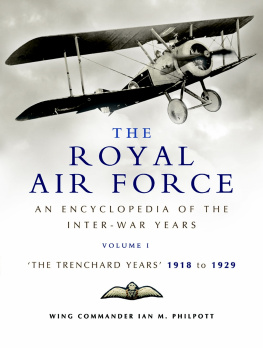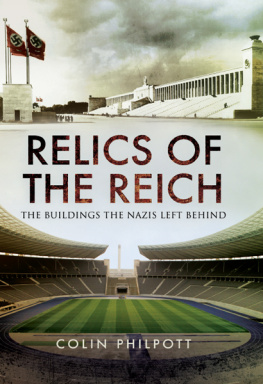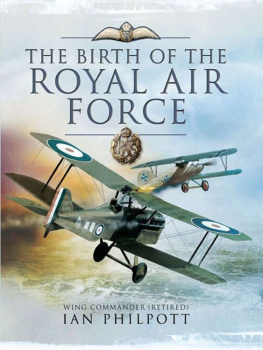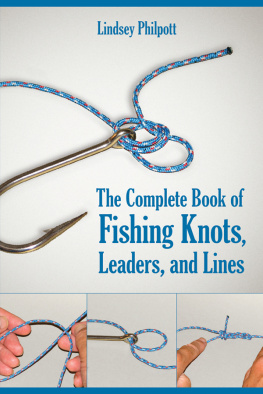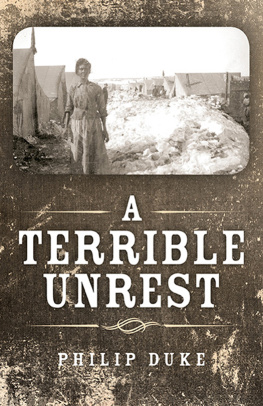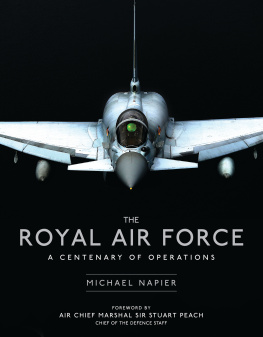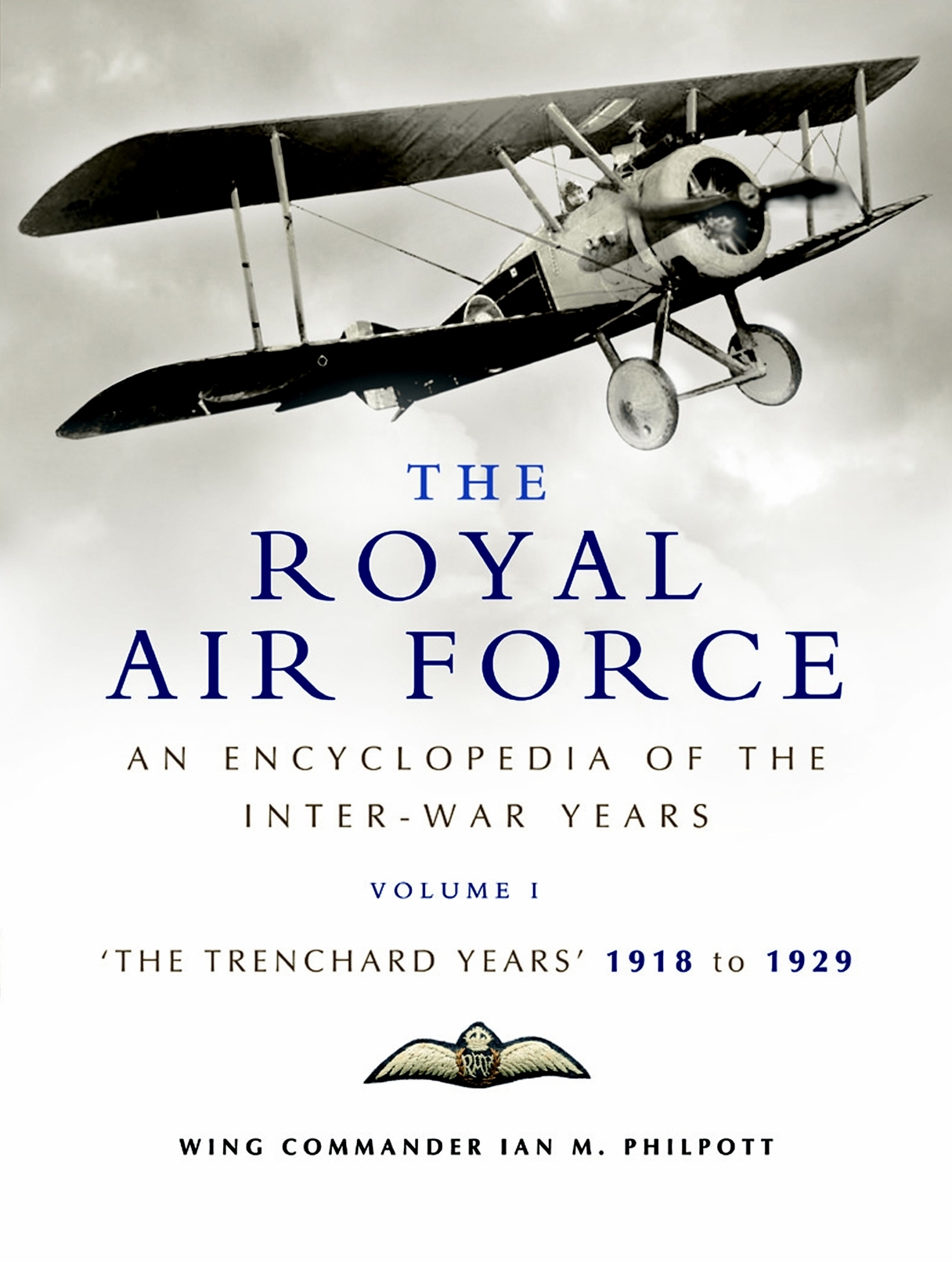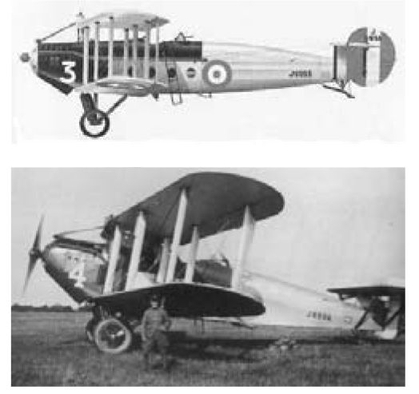Acknowledgements
To John James and publishers Macdonald and Co. for The Paladins , a social history of the RAF up to the outbreak of the Second World War II, which was the inspiration for undertaking the compilation of this encyclopaedia.
To the staff of the National Archives, Kew, for their help in providing source material covering a range of issues related to the development of British airpower in the inter-war years.
To Mr Peter Elliott and his research staff at the RAF Museum, Hendon, for their patient delving into matters relating to the RAF during the period 1918 to 1939.
To Group Captain Larkin at RAF Halton who provided expert knowledge of the Boy Apprentice scheme put into place by Air Marshal Trenchard in the early 1920s.
To Mr Claude Whistler CBE of Eastry, Nr Sandwich, Kent, who provided pictures and personal history of his father, who fought with distinction during the Great War and during operations on the North-West Frontier in India.
To Wing Commander C.G. Jefford MBE RAF (Retd), who gave advice, and for the use of material from his book on RAF squadrons that lists the whereabouts of RAF units for the period 1912 to the 1970s.
To Mr Gibbings of Agusta Westland, who helped with photographs.
To the author John W.R. Taylor and publishers Ian Allen for A Pictorial History of the RAF 1918 1939 , Vol. I. This book provided a wealth of useful photographs of the period.
To the Putnam Press and HMSO for the most useful accounts of the development of the aircraft industry from 1918 to 1939 as seen through the eyes of Harald Penrose, the chief test pilot of Westland during the period. (see bibliography).
To Karl Hayes and his history of the Royal Air Force and the United States Naval Air Service in Ireland 1913 1923, Irish Air Letter 1988.
To the authors and publishers of books listed in the bibliography not already mentioned.
Appendices
- A. Aircraft Technical Specifications
- B. Squadron Locations and Aircraft, 1918 to 1939
- C. The Trenchard Memorandum
- D. Flying Operations Carried Out by No. 11 (Irish) Wing, April 1921
- E Extract of Report on Iraq Administration by the High Commissioner April 1922 March 1923
- F. RAF Squadron Disbandments 1918 1923
- G. Strategic Air Doctrine 1921
- H. Military and Civil Aircraft Tested at Martlesham Heath. 1919 1929
- J. Administrative Arrangements for RAF Personnel to see the 1929 Schneider Trophy Contest
- K. Orders Issued for Joint Operations by Nos.1 and 2 (Indian) Wings on 5th and 6th June 1927 against Mohmand tribesmen.
- L. Arrangements for Naval Officer Volunteers for Service with the Fleet Air Arm (A.M.W.O. No.551)
- M. Pilots on the strength of Fighter, Fleet Spotter and Reconnaissance Flights of the Fleet Air Arm.
- N. The Career Paths of Hugh Trenchard, John Salmond, Frederick Sykes and Edward Ellington
- P. The Various Home and Tropical Officers uniforms 1925
- Q. Correspondence Relating to the Cabinet Memorandum The War Object of an Air Force
- R. Members of the Air Council and Commanders of RAF Formations in the 1920s.
- S. The Air Estimates Financial Year 1919 1920.
Appendix A
AIRCRAFT TECHNICAL SPECIFICATIONS
PART I AIRCRAFT IN OPERATIONAL SQUADRON SERVICE BETWEEN 11 NOVEMBER 1918 AND 31 DECEMBER 1929
PART II NON-SQUADRON TRAINING AIRCRAFT, HIGH-ALTITUDE, HIGH-SPEED AND LONG-DISTANCE AIRCRAFT
Notes:
- The information shown relates to a representative mark/version of the type.
- Details of test flying and development are to be found in Chapter 5.
- Aircraft by squadrons are shown in Appendix B.
PART I
AIRCRAFT IN OPERATIONAL SQUADRON SERVICE BETWEEN 11 NOVEMBER 1918 AND 31 DECEMBER 1929
- Avro Aldershot
- Armstrong Whitworth Atlas
- Avro 504K
- Armstrong Whitworth FK8
- Sopwith Baby
- Royal A/C Factory BE2E
- Royal A/C Factory BE12A
- Bristol F2B
- Bristol M1C
- Bristol Bulldog
- Sopwith Camel
- Fairey Campania
- Sopwith Cuckoo
- Curtiss H.12
- Curtiss H.16
- Airco DH4
- Airco DH6
- Airco DH9
- Airco DH9A
- Airco DH10
- Sopwith Dolphin
- Fairey IIID Land-Plane
- Fairey IIID Floatplane
- Fairey IIIF Land/Float Plane
- Fairey Fawn
- Felixstowe F2A
- Felixstowe F3
- Felixstowe F5
- Royal A/C Factory FE2B/C/D
- Fairey Fox
- Gloster Gamecock
- Gloster Grebe II
- Handley Page Hinaidi
- Hawker Horsley
- Handley Page 0/400
- Handley Page V/1500
- Handley Page Hyderabad
- Blackburn Kangaroo
- Martinsyde G100/102
- Nieuport 17, 23, 24
- Nieuport Nightjar
- Nieuport Nighthawk
- Parnall Panther
- Royal Aircraft Factory RE8
- Sopwith Salamander
- Royal Aircraft Factory SE5A
- Short 184
- Short 320
- Boulton Paul Sidestrand
- Armstrong Whitworth Siskin IIIA
- Sopwith Snipe
- Supermarine Southampton II
- SPAD VII
- Vickers Vernon
- Vickers Victoria
- Vickers Vimy
- Vickers Virginia
- Westland Walrus
- Westland Wapiti
- Wight Converted
- Hawker Woodcock
Aircraft Specification Sheet (1): AVRO ALDERSHOT
Span: 68 ft
Length: 45 ft
Wing area: 1,064 sq. ft Weights: Empty, 6,310 lb Loaded, 10,950 lb Power plant: One 650 hp Rolls-Royce Condor III Armament/Bomb load: One fixed Vickers forward-firing machine-gun, one trainable gun in mid-upper position and provision for one Lewis gun in ventral position; bomb load, 2,200 lb
Performance
Max. speed: 110 mph at sea level
Cruising speed: 92 mph
Endurance: 6 hr
Service ceiling: 14,500 ft
Air Ministry Specifications:
2/20, which called for a long-range bomber
History
The first prototype, J6852, made its maiden flight at Hamble, flown by Bert Hinkler in October 1921. The aircraft was in competition for RAF acceptance against a de Havilland Derby. The aircraft had a large four-bladed propeller and double undercarriage. The fuselage was metal-tube framed with wooden wings, fin and tail. The prototype was flown in the presence of Sir Geoffrey Salmond and Air Ministry officials. Hinkler took off in just 300 yards and reported that it was nice on the controls and easy to manage. The Aldershot was then delivered to RAE Farnborough, whose staff found it stable in flight, making it suitable for night flying. The Aldershot made a public appearance at the 1922 Hendon Air Pageant, flown by Flying Officer C.E. Horrex. Only fifteen were built, Serials J6942 to 6956, and it entered service as the Aldershot III (from J6945 onwards) in August 1924 with 99 Squadron at Bircham Newton, but remained in service only until the end of 1925, since it was by then Air Ministry policy not to employ any more single-engined heavy bombers. Given its weight, if one force-landed in a field it would have to be dismantled, whereas a two-engined bomber would be much less likely to suffer total engine failure. It was replaced by the twin-engined Hyderabad, which served with 99 Squadron for six years.
Aircraft Specification Sheet (2): ARMSTRONG WHITWORTH ATLAS
Span: 39 ft 6.5 in.
Length: 28 ft 6.5 in.
Wing area: 391 sq. ft
Weights: Empty, 2,550 lb

